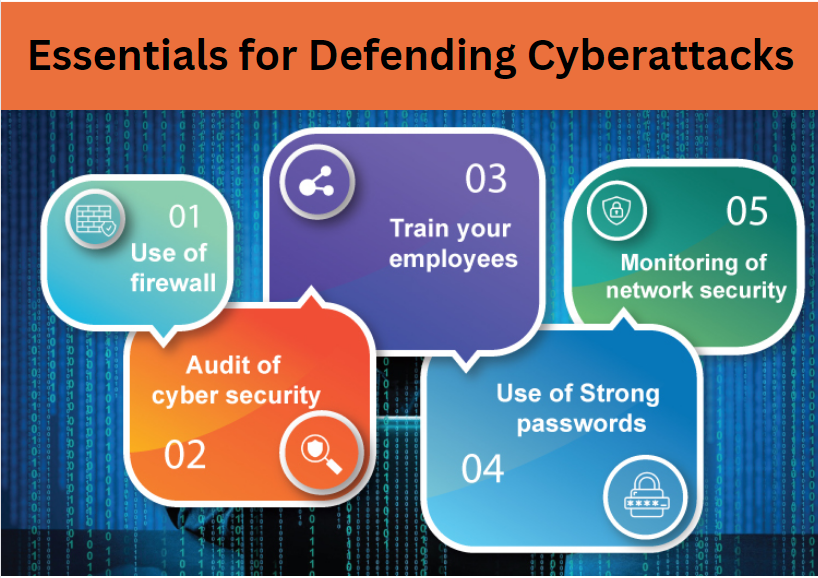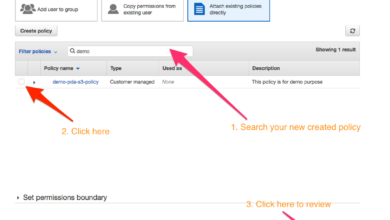
Breach Ready Fortifying Your Defenses
Breach ready fortifying your defenses in the age of cyberattacks – Breach Ready: Fortifying Your Defenses in the age of cyberattacks. In today’s digital world, cybersecurity isn’t just a buzzword; it’s a necessity. From sophisticated ransomware attacks crippling businesses to data breaches exposing sensitive customer information, the threat landscape is constantly evolving. This post dives deep into building a robust defense against these ever-present dangers, exploring practical strategies and cutting-edge technologies to protect your valuable assets.
We’ll cover everything from establishing a strong cybersecurity foundation – encompassing network security, employee training, and robust data protection – to implementing advanced threat detection and prevention measures. We’ll also delve into vulnerability management, compliance requirements, and the crucial role of incident response planning. Get ready to transform your approach to cybersecurity and significantly reduce your risk.
Understanding the Modern Threat Landscape
The digital world has become the lifeblood of modern businesses, but this interconnectedness also exposes organizations to an ever-evolving and increasingly sophisticated range of cyberattacks. The threat landscape is dynamic, with attackers constantly developing new techniques to bypass security measures and exploit vulnerabilities. Understanding this landscape is crucial for effective defense.The sophistication of cyberattacks has increased dramatically in recent years.
Attackers are employing advanced techniques like AI-powered malware, polymorphic viruses that constantly change their code to evade detection, and highly targeted phishing campaigns designed to bypass even the most robust security protocols. The sheer volume of attacks, coupled with their increasing complexity, presents a significant challenge for businesses of all sizes.
Prevalent Types of Business Breaches
The most common types of breaches targeting businesses today fall into several categories. Data breaches, involving the theft of sensitive customer or company information, remain a major concern. Ransomware attacks, which encrypt an organization’s data and demand payment for its release, are also extremely prevalent. Denial-of-service (DoS) attacks, which overwhelm a system with traffic to render it unusable, can disrupt business operations significantly.
Supply chain attacks, targeting vulnerabilities in a company’s vendors or partners, are also on the rise, highlighting the interconnected nature of modern business risk. Finally, insider threats, originating from malicious or negligent employees, represent a significant, often underestimated, risk.
Commonly Exploited Vulnerabilities
Attackers frequently exploit known vulnerabilities in software and hardware to gain access to systems. Outdated software, lacking security patches, is a prime target. Weak or easily guessable passwords remain a significant vulnerability, despite repeated warnings. Unpatched operating systems and applications provide easy entry points for malware. Phishing emails, designed to trick users into revealing sensitive information, continue to be highly effective.
Human error, including clicking on malicious links or downloading infected files, remains a common factor in many breaches. Finally, inadequate network security, such as a lack of firewalls or intrusion detection systems, can significantly increase an organization’s vulnerability.
Real-World Breach Scenarios and Impact
The 2017 Equifax breach, resulting in the exposure of personal information for over 147 million people, serves as a stark example of the devastating consequences of data breaches. The NotPetya ransomware attack in 2017 caused billions of dollars in damage globally, disrupting businesses across various sectors. The SolarWinds supply chain attack in 2020 demonstrated the vulnerability of organizations to attacks targeting their vendors, highlighting the need for robust supply chain security measures.
These examples illustrate the significant financial, reputational, and legal repercussions that can result from successful cyberattacks. The cost of a breach extends far beyond the immediate financial losses, encompassing legal fees, regulatory penalties, and the long-term damage to customer trust.
Building a Strong Cybersecurity Foundation
A robust cybersecurity foundation isn’t a single, impenetrable wall; it’s a multi-layered defense system designed to withstand and mitigate various attack vectors. Think of it as a castle with multiple moats, walls, and guards, each offering a different level of protection. Neglecting even one layer weakens the entire structure, leaving your valuable data vulnerable. This section explores the crucial elements of building such a resilient foundation.A multi-layered security approach is paramount in today’s threat landscape.
Relying on a single security measure is like leaving your front door unlocked while relying solely on a security camera. A comprehensive strategy incorporates multiple layers of defense, working in concert to protect your systems and data. If one layer fails, others are in place to prevent a breach. This layered approach includes network security, endpoint protection, data loss prevention, user education, and incident response planning.
Each layer complements the others, creating a robust and resilient defense.
Network Security Best Practices
Securing your network is foundational to overall cybersecurity. This involves implementing firewalls to control network traffic, regularly updating network devices with the latest security patches, and employing intrusion detection and prevention systems (IDPS) to monitor for and respond to malicious activity. Virtual Private Networks (VPNs) should be used to encrypt data transmitted over public networks, protecting sensitive information from eavesdropping.
Being breach-ready means constantly upgrading your cybersecurity. A key element of this is strong cloud security, and that’s where understanding tools like Bitglass comes in. Check out this great resource on bitglass and the rise of cloud security posture management to see how it helps fortify your defenses against modern threats. Ultimately, proactive measures like this are crucial for staying ahead in the ever-evolving landscape of cyberattacks.
Regular security audits and penetration testing are also vital to identify and address vulnerabilities before attackers can exploit them. For example, a company might use a firewall to block unauthorized access from external networks, while an IDPS monitors network traffic for suspicious patterns, alerting security personnel to potential threats.
Endpoint Security Best Practices
Endpoints – computers, laptops, smartphones, and other devices accessing your network – are often the weakest link in the security chain. Strong endpoint security requires installing and regularly updating antivirus and anti-malware software, enabling strong password policies and multi-factor authentication (MFA), and employing endpoint detection and response (EDR) solutions to monitor for and respond to threats on individual devices.
Regular software updates and patching are crucial to address known vulnerabilities. Consider implementing device management solutions to control access and monitor activity on endpoints. For instance, a company might use EDR software to detect and respond to malware infections on individual laptops, while strong password policies prevent unauthorized access.
Employee Training and Awareness
Human error remains a significant contributor to security breaches. Comprehensive employee training is essential to raise awareness of phishing scams, social engineering tactics, and other common attack vectors. Regular security awareness training, including simulated phishing campaigns, can significantly reduce the risk of human error. Training should cover safe browsing practices, password management, and the importance of reporting suspicious activity.
Furthermore, clear guidelines on acceptable use of company resources should be established and communicated effectively. For example, a company might conduct annual security awareness training sessions and simulate phishing attacks to test employees’ vigilance and response.
Basic Cybersecurity Policy
A well-defined cybersecurity policy is the cornerstone of a strong security posture. This policy should Artikel key principles, procedures, and responsibilities related to data security, access control, incident response, and acceptable use of company resources. It should define roles and responsibilities for security management and incident handling. The policy should be readily accessible to all employees and regularly reviewed and updated to reflect changes in the threat landscape and company needs.
For example, a cybersecurity policy might stipulate that all employees must use strong passwords, report suspicious emails, and attend annual security awareness training. It might also Artikel procedures for handling data breaches and security incidents.
Data Protection and Recovery Strategies: Breach Ready Fortifying Your Defenses In The Age Of Cyberattacks
In today’s digital landscape, robust data protection and recovery strategies are no longer optional; they’re essential for business survival. A single data breach can lead to significant financial losses, reputational damage, and legal repercussions. This section delves into the key elements of building a comprehensive data protection and recovery plan. We’ll explore encryption methods, incident response procedures, backup solutions, and the pros and cons of various technologies.
Data Encryption and Secure Storage
Protecting data at rest and in transit is paramount. Data encryption transforms readable data into an unreadable format, rendering it useless to unauthorized individuals. Several encryption methods exist, each with its strengths and weaknesses. Symmetric encryption uses the same key for both encryption and decryption, offering speed but posing challenges in key distribution. Asymmetric encryption, on the other hand, employs separate keys (public and private), enhancing security but sacrificing some speed.
Secure storage involves utilizing encrypted hard drives, cloud storage with robust security features, and access control lists to restrict access to authorized personnel only. Implementing multi-factor authentication adds an extra layer of protection. Regular security audits and vulnerability assessments are crucial for identifying and mitigating potential weaknesses in your data protection infrastructure.
Incident Response and Data Breach Recovery
A well-defined incident response plan is critical for minimizing the impact of a data breach. This plan should Artikel clear procedures for identifying, containing, eradicating, recovering from, and learning from a security incident. Key steps include immediately isolating affected systems, conducting a thorough investigation to determine the extent of the breach, notifying relevant authorities and affected individuals, restoring data from backups, and implementing measures to prevent future incidents.
Regular simulations and training exercises are essential to ensure that your team is prepared to effectively respond to a real-world event. For example, a simulated phishing attack can help identify vulnerabilities in your employee training and response protocols. The speed and efficiency of your response directly impact the overall damage caused by a breach.
Backup and Recovery Solutions
Various backup and recovery solutions exist, each with its own advantages and disadvantages. Local backups offer speed and simplicity but are vulnerable to physical damage or theft. Cloud backups provide offsite protection and scalability but rely on internet connectivity and the security of the cloud provider. Hybrid solutions combine local and cloud backups to leverage the strengths of both approaches.
Choosing the right solution depends on factors like budget, data volume, recovery time objectives (RTO), and recovery point objectives (RPO). For example, a hospital with critical patient data might opt for a robust hybrid solution with frequent backups and quick recovery times, while a small business might find a cloud-based solution sufficient. Regular testing of your backup and recovery processes is crucial to ensure they function as intended in the event of a disaster.
Comparison of Data Protection Technologies
| Technology | Pros | Cons | Suitable for |
|---|---|---|---|
| Symmetric Encryption | Fast, simple to implement | Key distribution challenges, less secure than asymmetric encryption | Internal communication, data at rest with strong access controls |
| Asymmetric Encryption | Stronger security, better key management | Slower than symmetric encryption, more complex to implement | Secure communication, digital signatures, public key infrastructure |
| Local Backups | Fast, inexpensive | Vulnerable to physical damage, limited redundancy | Small businesses with limited data and budget |
| Cloud Backups | Scalable, offsite protection | Relies on internet connectivity, potential security risks with the provider | Businesses with large data volumes, requiring high availability |
Advanced Threat Detection and Prevention
In today’s complex cyber landscape, relying solely on preventative measures is insufficient. Advanced threat detection and prevention strategies are crucial for organizations to identify and neutralize sophisticated attacks before they cause significant damage. This involves a multi-layered approach encompassing various technologies and techniques, working in concert to provide comprehensive security.
Effective threat detection and prevention hinge on the ability to monitor network traffic and system activity for malicious behavior, analyze that data to identify potential threats, and respond swiftly to neutralize those threats. This requires a combination of technology and skilled security personnel.
Intrusion Detection and Prevention Systems (IDS/IPS) Functionality
Intrusion Detection Systems (IDS) passively monitor network traffic and system activity for suspicious patterns, alerting security personnel to potential threats. Intrusion Prevention Systems (IPS), on the other hand, actively block or mitigate identified threats. IDS/IPS leverage various techniques, including signature-based detection (identifying known attack patterns), anomaly-based detection (detecting deviations from established baselines), and behavioral analysis (monitoring user and system behavior for unusual activity).
A well-configured IDS/IPS acts as a critical first line of defense, identifying and responding to a wide range of threats, from simple port scans to sophisticated exploits. For example, an IPS might block a known malware signature attempting to establish a connection, while an IDS would simply log the event and alert administrators.
Security Information and Event Management (SIEM) Tools
SIEM tools aggregate and analyze security logs from various sources across an organization’s IT infrastructure. These sources include network devices, servers, endpoints, and security applications. By correlating events across different systems, SIEM tools provide a comprehensive view of security posture and help identify potential threats that might otherwise go unnoticed. Popular SIEM tools include Splunk, IBM QRadar, and LogRhythm.
These platforms offer features like real-time threat detection, security incident response management, and compliance reporting. For instance, a SIEM system might detect a series of failed login attempts from an unusual geographic location, indicating a potential brute-force attack.
Utilizing Threat Intelligence Feeds for Proactive Defense
Threat intelligence feeds provide organizations with up-to-date information on emerging threats, vulnerabilities, and attack techniques. These feeds, often sourced from security vendors, government agencies, and research organizations, enable proactive security measures. By integrating threat intelligence into security systems, organizations can prioritize patching vulnerabilities, configure security controls more effectively, and develop more targeted threat detection rules. For example, if a threat intelligence feed indicates a new exploit targeting a specific application, organizations can immediately patch the vulnerability and configure their IDS/IPS to detect and block the exploit.
Advanced Threat Detection Techniques
Advanced threat detection employs sophisticated techniques to identify and respond to sophisticated attacks that bypass traditional security measures. These techniques include machine learning, which can identify subtle anomalies in network traffic or system behavior, and sandboxing, which isolates suspicious files or code in a controlled environment to analyze their behavior without risking infection. Another technique is deception technology, which uses decoys and traps to lure attackers and gather intelligence about their tactics and techniques.
For example, machine learning algorithms can detect unusual patterns in network communication that might indicate a command-and-control server communication, even if the communication itself is encrypted.
Vulnerability Management and Patching
Maintaining a robust vulnerability management program is crucial in today’s threat landscape. Failing to address known weaknesses leaves your systems vulnerable to exploitation, potentially leading to data breaches, financial losses, and reputational damage. A proactive approach, encompassing regular scanning, patching, and testing, is paramount for minimizing risk.A robust vulnerability management process involves a continuous cycle of identifying, assessing, remediating, and verifying vulnerabilities.
This isn’t a one-time task; it requires ongoing attention and adaptation to the ever-evolving threat landscape. Effective implementation demands a combination of automated tools and skilled personnel.
Vulnerability Identification and Assessment, Breach ready fortifying your defenses in the age of cyberattacks
Identifying vulnerabilities requires a multi-pronged approach. Automated vulnerability scanners regularly scan your systems and applications for known weaknesses, providing a list of potential problems. These scanners leverage vulnerability databases like the National Vulnerability Database (NVD) to compare your systems’ configurations against known exploits. Manual penetration testing, performed by security experts, simulates real-world attacks to uncover vulnerabilities that automated scanners might miss.
This combination provides a more comprehensive view of your security posture. The assessment process then prioritizes these vulnerabilities based on their severity and potential impact, allowing you to focus on the most critical issues first. A common scoring system used is the Common Vulnerability Scoring System (CVSS), which provides a numerical score indicating the severity of a vulnerability.
Software Patching and Update Best Practices
Prompt patching and updating of software is paramount to mitigating vulnerabilities. Regularly check for updates from software vendors and implement a standardized patching process. Before deploying patches, thoroughly test them in a non-production environment to ensure compatibility and to avoid unexpected disruptions. Automate the patching process as much as possible to reduce the manual effort and human error.
Prioritize patching critical vulnerabilities first, focusing on those with high CVSS scores and known exploits. Maintain an inventory of all software and hardware assets to ensure comprehensive patching coverage. Develop a robust change management process to track and document all patch deployments.
Regular Security Assessments and Penetration Testing
Regular security assessments and penetration testing are not merely compliance exercises; they are vital for proactive threat mitigation. Security assessments provide a holistic overview of your security posture, identifying weaknesses in your infrastructure, policies, and procedures. Penetration testing simulates real-world attacks to uncover vulnerabilities that might otherwise go unnoticed. These tests should cover a range of attack vectors, including network attacks, application vulnerabilities, and social engineering.
The results of these assessments and tests should be used to inform your vulnerability management program, driving improvements and strengthening your defenses. Regular testing, at least annually, and more frequently for critical systems, is recommended.
Addressing Identified Vulnerabilities: A Step-by-Step Procedure
Addressing vulnerabilities requires a systematic approach. First, verify the vulnerability using multiple sources to confirm its existence and impact. Next, prioritize the vulnerability based on its severity and potential impact. Then, develop a remediation plan, outlining the steps needed to address the vulnerability. This might involve patching, configuration changes, or implementing compensating controls.
Implement the remediation according to the plan, carefully documenting all changes. Finally, verify the remediation by rescanning the system to confirm that the vulnerability has been successfully addressed. This entire process should be documented and tracked, ensuring accountability and continuous improvement.
Compliance and Regulatory Requirements

Navigating the complex world of cybersecurity isn’t just about protecting your data; it’s about adhering to a growing number of regulations designed to safeguard sensitive information. Non-compliance can lead to significant financial penalties, reputational damage, and even legal action. Understanding and meeting these requirements is crucial for any organization, regardless of size.The landscape of cybersecurity regulations is constantly evolving, reflecting the increasing sophistication of cyber threats and the growing reliance on digital systems.
Failure to comply can result in hefty fines, lawsuits, loss of customer trust, and damage to your brand’s image. Proactive compliance, however, can demonstrate your commitment to data security, build customer confidence, and ultimately reduce your risk exposure.
Relevant Cybersecurity Regulations and Compliance Standards
Several key regulations and standards govern data protection and cybersecurity practices globally. The General Data Protection Regulation (GDPR) in Europe, for example, sets strict rules for the processing of personal data. In the United States, the Health Insurance Portability and Accountability Act (HIPAA) protects the privacy and security of protected health information (PHI). Other important standards include the Payment Card Industry Data Security Standard (PCI DSS) for organizations handling credit card information, and the California Consumer Privacy Act (CCPA), which grants California residents specific rights regarding their personal data.
These regulations often overlap, requiring a comprehensive approach to compliance. Understanding the specific requirements applicable to your organization’s industry and geographic location is paramount.
Implications of Non-Compliance
Non-compliance with cybersecurity regulations carries substantial consequences. Financial penalties can range from thousands to millions of dollars, depending on the severity of the violation and the applicable regulations. Reputational damage can be equally devastating, leading to loss of customer trust, decreased market share, and difficulty attracting investors. Legal repercussions, including lawsuits and criminal charges, are also potential outcomes of non-compliance.
In some cases, non-compliance can even result in the suspension or revocation of business licenses or operating permits. The impact of non-compliance extends beyond immediate financial losses; it can severely damage an organization’s long-term sustainability and success.
Implementing Controls to Meet Regulatory Requirements
Meeting regulatory requirements necessitates a multi-faceted approach. This involves implementing robust security controls across various areas, including access control, data encryption, vulnerability management, incident response planning, employee training, and regular security audits. A comprehensive risk assessment should be conducted to identify vulnerabilities and prioritize mitigation efforts. Regular security awareness training for employees is crucial to ensure they understand their role in maintaining data security and complying with regulations.
Data encryption protects sensitive information both in transit and at rest. Implementing strong access control measures, such as multi-factor authentication, limits unauthorized access to systems and data. Regular security audits and penetration testing help identify weaknesses in your security posture before they can be exploited. Maintaining detailed records of security policies, procedures, and incidents is also essential for demonstrating compliance.
Compliance Checklist and Deadlines
Creating a detailed checklist of compliance tasks and their associated deadlines is essential for effective management. This checklist should be tailored to the specific regulations applicable to your organization. For example, if your organization handles PHI, your checklist will need to address HIPAA requirements, including the implementation of safeguards for electronic protected health information (ePHI). Similarly, if you process personal data of European Union residents, your checklist will need to incorporate GDPR compliance measures.
The checklist should include tasks such as conducting regular risk assessments, implementing security controls, conducting employee training, performing security audits, and maintaining comprehensive documentation. Each task should have a clearly defined deadline, and progress should be regularly monitored and documented. Regular review and updates to the checklist are crucial to keep pace with evolving regulations and technological advancements.
Consider using project management software to help track progress and ensure timely completion of all tasks.
Security Awareness and Training
A strong cybersecurity posture isn’t solely reliant on technical safeguards; it hinges critically on the human element. Employees are often the weakest link in the security chain, inadvertently opening doors for attackers through simple mistakes. A comprehensive security awareness training program is therefore paramount, fostering a security-conscious culture that proactively mitigates risk. This involves not just imparting knowledge but also changing behaviors and creating a mindset where security is everyone’s responsibility.Regular training is essential to keep employees updated on the latest threats and best practices.
The effectiveness of such training is measured not just by completion rates but by demonstrable changes in employee behavior and a reduction in security incidents.
In today’s digital landscape, being breach-ready is paramount. Fortifying your defenses means embracing modern development practices, and that includes exploring innovative solutions like those discussed in this insightful article on domino app dev, the low-code and pro-code future. Understanding these advancements helps build more secure and robust applications, ultimately strengthening your overall cyber security posture against increasingly sophisticated threats.
Phishing Simulations and Social Engineering Tactics
Phishing attacks remain a prevalent threat, exploiting human psychology to trick individuals into revealing sensitive information. Simulations are crucial for educating employees about these tactics. For example, a realistic phishing email might mimic a notification from a known bank or a trusted colleague, urging the recipient to click a malicious link or download a harmful attachment. Successful simulations highlight vulnerabilities and demonstrate the real-world consequences of falling prey to such attacks.
Another example could involve a social engineering scenario where a malicious actor impersonates a help desk representative, attempting to extract login credentials. These exercises are designed to build vigilance and skepticism towards suspicious communications.
Promoting a Security-Conscious Culture
Cultivating a security-conscious culture transcends simple training; it requires embedding security into the organizational fabric. This can be achieved through various methods, such as integrating security into performance reviews, recognizing and rewarding employees who demonstrate exemplary security practices, and fostering open communication where employees feel comfortable reporting security incidents without fear of reprisal. Regular communication campaigns, highlighting recent threats and best practices, can reinforce security awareness.
Leadership buy-in is crucial; visible support from senior management sends a powerful message about the importance of security to the entire organization. Regular security newsletters, company-wide announcements, and interactive security awareness games can also be employed.
Key Security Awareness Topics for Different Employee Roles
The specific security awareness topics should be tailored to the roles and responsibilities of different employees. For instance, employees with access to sensitive financial data require more extensive training on data protection and privacy regulations than those in less sensitive roles.A table outlining key topics for different roles can effectively summarize this:
| Employee Role | Key Security Awareness Topics |
|---|---|
| Executive Management | Data governance, risk management, regulatory compliance, incident response |
| IT Staff | Advanced threat detection, vulnerability management, security incident response, incident reporting procedures |
| Finance Department | Data security, PCI DSS compliance, fraud prevention, phishing awareness |
| Human Resources | Data privacy, employee onboarding security training, background checks |
| General Employees | Password security, phishing awareness, social engineering, physical security, data loss prevention |
The Role of Technology in Fortifying Defenses
Technology plays a crucial role in bolstering cybersecurity defenses in today’s interconnected world. While no single technology offers complete protection, a layered approach incorporating various tools and strategies significantly enhances overall security posture. Understanding the strengths and weaknesses of different technologies is vital for effective implementation and management.
Effective cybersecurity relies on a multi-faceted approach, combining robust technologies with well-defined security policies and trained personnel. The integration of these elements creates a comprehensive defense system capable of mitigating a wide range of threats.
Firewall Functionality and Limitations
Firewalls act as the first line of defense, inspecting network traffic and blocking unauthorized access. They work by examining packets of data, comparing them against predefined rules, and either allowing or denying passage based on source and destination IP addresses, ports, and protocols. While highly effective in preventing many attacks, firewalls are not foolproof. Sophisticated attacks, such as those using encrypted tunnels or exploiting zero-day vulnerabilities, can bypass firewall restrictions.
Furthermore, misconfiguration of firewall rules can inadvertently create security loopholes. Regular updates and meticulous configuration are essential for maintaining firewall effectiveness.
Virtual Private Network (VPN) Benefits and Considerations
VPNs encrypt data transmitted over public networks, providing secure communication channels. This is particularly crucial for remote workers accessing company resources or individuals using public Wi-Fi. VPNs mask the user’s IP address, enhancing anonymity and security. However, reliance solely on VPNs is insufficient. A compromised VPN server or client could negate its protective capabilities.
Therefore, VPNs should be part of a broader security strategy, complemented by other security measures.
Anti-malware Software Effectiveness and Challenges
Anti-malware software plays a vital role in detecting and removing malicious software. These programs employ various techniques, including signature-based detection (matching known malware signatures) and heuristic analysis (identifying suspicious behavior). While effective against many known threats, anti-malware solutions struggle with emerging malware variants and sophisticated attacks employing polymorphism or obfuscation techniques. Regular updates and proactive scanning are crucial for maximizing their effectiveness.
Furthermore, user education is vital, as many malware infections originate from user error.
Authentication Methodologies and Security Implications
Several authentication methods exist, each with varying levels of security. Password-based authentication, while widely used, is susceptible to brute-force attacks and phishing. Multi-factor authentication (MFA), requiring multiple forms of verification (e.g., password, one-time code, biometric scan), significantly enhances security by adding layers of protection. Biometric authentication, using fingerprints or facial recognition, offers strong security but raises privacy concerns.
The choice of authentication method depends on the sensitivity of the data and the acceptable level of risk. A balanced approach, incorporating multiple methods, is often the most effective strategy.
Cloud-Based Security Solutions and Their Applications
Cloud-based security solutions offer scalability, cost-effectiveness, and centralized management. Cloud security providers offer a range of services, including intrusion detection and prevention systems, data loss prevention tools, and vulnerability scanning. However, relying solely on cloud-based solutions necessitates careful consideration of data sovereignty, vendor lock-in, and the provider’s security posture. A thorough assessment of the provider’s security certifications and compliance standards is essential.
Integrating Security Tools for a Cohesive System
Integrating various security tools into a cohesive system is crucial for effective threat management. This involves establishing a centralized security information and event management (SIEM) system that collects and analyzes security logs from multiple sources. The SIEM system can then identify patterns and anomalies, providing early warnings of potential security breaches. This integrated approach allows for proactive threat detection, rapid response, and continuous improvement of the overall security posture.
For example, a SIEM system could correlate alerts from a firewall, intrusion detection system, and anti-malware software to pinpoint a coordinated attack.
Responding to and Recovering from a Breach
A cybersecurity breach is a devastating event, capable of crippling an organization financially, reputationally, and legally. Having a robust incident response plan isn’t just a best practice; it’s a necessity. This plan should be tested regularly and updated to reflect evolving threats and your organization’s changing infrastructure. The speed and effectiveness of your response directly impacts the severity of the damage.
Incident Response Plan Steps
A comprehensive incident response plan Artikels the steps your organization will take from the initial detection of a security incident to the final recovery and lessons learned. This plan should be clearly documented, easily accessible, and understood by all relevant personnel. It should also include contact information for key personnel and external resources, such as law enforcement and legal counsel.
- Preparation: This involves identifying potential threats, establishing communication protocols, and defining roles and responsibilities. Regular security awareness training for employees is crucial here.
- Detection and Analysis: This stage focuses on identifying the breach, determining its scope, and analyzing the impact. This may involve analyzing logs, network traffic, and security alerts.
- Containment: The goal here is to isolate the affected systems to prevent further damage or spread of malware. This could involve disconnecting affected systems from the network, blocking malicious IP addresses, or implementing temporary access restrictions.
- Eradication: This involves removing the malware and restoring affected systems to a clean state. This may involve reinstalling operating systems, restoring from backups, and implementing security patches.
- Recovery: This involves restoring systems and data to normal operation, verifying the integrity of the systems, and restoring data from backups.
- Post-Incident Activity: This crucial step involves analyzing the incident to identify weaknesses in your security posture, implementing corrective actions, and updating your incident response plan. A thorough post-mortem analysis helps prevent future breaches.
Malware Containment and Eradication
Containing and eradicating malware requires a systematic approach. Speed is critical; the longer malware remains active, the greater the potential damage.
- Isolate Affected Systems: Immediately disconnect infected systems from the network to prevent the spread of malware. This might involve physically unplugging devices or using network segmentation techniques.
- Identify and Quarantine Malware: Use anti-malware software and forensic tools to identify the type of malware and its location. Quarantine the malware to prevent further execution.
- Remove Malware: This may involve using specialized removal tools, reinstalling operating systems, or restoring systems from clean backups. Thoroughly scan all systems for residual malware.
- Remediate Vulnerabilities: After removing the malware, address the vulnerabilities that allowed the malware to gain access in the first place. This often involves patching software and updating security configurations.
Effective Communication During a Breach
Open and honest communication is vital during a breach. This involves promptly notifying affected parties, including customers, employees, and regulatory bodies, as required by law.
Transparency builds trust and minimizes reputational damage. A well-defined communication plan should Artikel who is responsible for communicating with different stakeholders, the messages to be delivered, and the communication channels to be used. This plan should address different scenarios, such as a data breach involving customer data versus a less severe internal security incident.
Incident Response Process Flowchart
Imagine a flowchart with boxes representing each stage of the incident response process. The process begins with “Incident Detection,” leading to “Initial Assessment” and then branching into “Containment,” “Eradication,” “Recovery,” and finally “Post-Incident Activity.” Each stage has a clear description and potential decision points, for example, a decision to escalate the incident based on its severity. Feedback loops are included to allow for iterative adjustments throughout the process.
The flowchart clearly visualizes the entire process, making it easy to understand and follow during a crisis. A clear visual representation like this aids in efficient and effective response.
Future Trends in Cybersecurity
The cybersecurity landscape is constantly evolving, driven by technological advancements and the ingenuity of malicious actors. Predicting the future is inherently uncertain, but by analyzing current trends and emerging technologies, we can anticipate the challenges and opportunities that lie ahead. This exploration focuses on key emerging threats, the expanding role of AI and machine learning, and innovative security technologies poised to reshape breach prevention and response.
Emerging Threats and Vulnerabilities
The threat landscape is broadening beyond traditional malware and phishing attacks. We’re seeing a rise in sophisticated attacks targeting critical infrastructure, leveraging vulnerabilities in IoT devices, and exploiting the increasing reliance on cloud services. Supply chain attacks, where attackers compromise a vendor to gain access to their clients, are also becoming increasingly prevalent and difficult to detect. Furthermore, the growing use of AI by attackers themselves is creating new challenges for defenders.
For instance, AI-powered phishing attacks are becoming more convincing and difficult to distinguish from legitimate communications. The exploitation of zero-day vulnerabilities, which are flaws unknown to vendors, continues to be a significant concern, demanding proactive and rapid response mechanisms.
The Role of Artificial Intelligence and Machine Learning in Cybersecurity
AI and machine learning are transforming cybersecurity defense. AI-powered systems can analyze vast amounts of data to identify patterns and anomalies indicative of malicious activity far faster and more efficiently than human analysts alone. This includes detecting advanced persistent threats (APTs), which are often difficult to spot using traditional methods. Machine learning algorithms are used in threat intelligence platforms to predict potential attacks based on historical data and emerging trends.
Furthermore, AI can automate many repetitive security tasks, such as vulnerability scanning and incident response, freeing up human analysts to focus on more complex issues. For example, AI-powered security information and event management (SIEM) systems can correlate security logs from various sources to identify and prioritize potential threats.
Predictions for the Future of Breach Prevention and Response
We can expect to see a continued shift towards proactive security measures, focusing on preventing breaches before they occur rather than solely reacting to them. This includes a greater emphasis on automated threat detection and response, leveraging AI and machine learning to identify and neutralize threats in real-time. Zero Trust security models, which assume no implicit trust within a network, will become increasingly important in protecting against lateral movement within compromised systems.
Furthermore, the development of more robust and resilient systems, capable of withstanding attacks and quickly recovering from breaches, will be crucial. For instance, the adoption of blockchain technology for secure data storage and management is gaining traction, offering enhanced immutability and protection against data tampering.
Innovative Security Technologies on the Horizon
Several innovative security technologies are on the horizon, promising to enhance breach prevention and response capabilities. Quantum-resistant cryptography is being developed to protect against attacks from future quantum computers, which could break current encryption methods. Post-quantum cryptography algorithms are being rigorously tested and standardized to ensure secure communication in a post-quantum world. Blockchain technology, beyond its use in data storage, is also being explored for secure identity management and access control, reducing reliance on centralized systems vulnerable to compromise.
Advanced behavioral analytics, utilizing AI and machine learning, are improving the detection of insider threats and anomalous user behavior, providing early warnings of potential breaches. The development and implementation of these technologies will significantly enhance the overall security posture of organizations.
Final Wrap-Up

Building a truly breach-ready organization requires a proactive, multi-faceted approach. It’s not just about installing the latest security software; it’s about fostering a culture of security awareness, investing in robust technologies, and developing a comprehensive incident response plan. By understanding the evolving threat landscape and implementing the strategies Artikeld in this post, you can significantly bolster your defenses and protect your business from the devastating consequences of a cyberattack.
Remember, staying ahead of the curve is key in the ever-changing world of cybersecurity.
FAQ Section
What is the biggest cybersecurity threat facing businesses today?
Ransomware attacks are currently a major threat, often targeting critical systems and demanding large sums of money for data recovery. Phishing and social engineering attacks remain prevalent, exploiting human error to gain access to sensitive information.
How often should I update my software?
Software updates should be applied as soon as they are released to patch known vulnerabilities. A regular patching schedule, ideally automated, is crucial.
What’s the difference between IDS and IPS?
An Intrusion Detection System (IDS) monitors network traffic for suspicious activity and alerts administrators. An Intrusion Prevention System (IPS) goes a step further, actively blocking malicious traffic.
What should I do if I suspect a data breach?
Immediately activate your incident response plan. Isolate affected systems, gather evidence, and contact law enforcement and relevant authorities.





